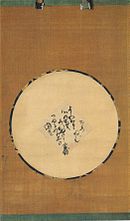Kobori Masakazu
Kobori Masakazu ( Japanese 小 堀 政 一 ; * 1579 ; † March 12, 1647 ), better known as Kobori Enshū ( 小 堀 遠 州 ), belonged to the sword nobility and was a builder and garden architect of the Shogunate at the beginning of the Edo period . Today he is best known as the founder of the Enshū school of tea ceremonies .
Live and act
Masakazu was born in Kobori Village, Sakata County, Ōmi Province . His father, Masatsugi, served the daimyo Asai Nagamasa , Hashiba Hidenaga and Tokugawa Ieyasu and after the Battle of Sekigahara he received himself daimyo rank with an income of 12,000 koku . After the death Masatsugis 1604 Masakazu took over his office, was lord of Omuro- han ( 小室藩 ) with the honorary title Tōtōmi no kami . Since that time he called himself Enshū, after the alternative name of the province of Tōtōmi. In 1616 he was appointed building commissioner ( 作事 奉行 , sakuji-bugyō ) for the residence of the ex-emperor Go-Yōzei .
1624 Enshū was appointed commissioner for Fushimi ( 伏 見 奉行 , Fushimi-bugyō ), the place where Fushimi Castle was located, an office he held until the end of his life. He introduced the shoguns Tokugawa Hidetada and Iemitsu to the tea ceremony, was a confidante of Tōdō Takatora and taught with his rich classical knowledge.
Construction activities
- Edo Castle
- Sumpu Castle
- Nagoya Castle (here the Tenshu)
- Fushimi Castle (Hommaru)
- Kinri (Gosho) of the Emperor Go-Mizunoo
- Residence of the wife of Emperor Go-Mizunoo, Tokugawa Masako / Kazuko ( 徳 川 和 子 )
- Osaka Castle (Tenshu, Hommaru)
- Sento residence ex-Emperor Go-Mizunoo
- Castle Nijō residence: Ni-no-maru
- Minakuchi Castle ( 水口 城 ) in Kōka in Ōmi Province
- Tōkai-ji ( 東海 寺 ) in Edo , garden
- Various other gardens
Enshū as a tea master
Enshū learned the tea ceremony at the age of ten with Sen no Rikyū in Kōriyama Castle ( Yamato Province ) and soon mastered it so that he could practice it as a host ( 点 前 , temae ). Later, however, he oriented himself more to the less strict tea ceremony of Furuta Oribe (1544–1615) and followed the Oribe line. While teaching the third daimyo Iemitsu, he developed a type of tea ceremony with the daisu ( 台子 ) as the center and the principle of kirei-sabi
Some of his teahouses still exist, such as the Hassō-no-seki in Konchi-in ( 金 地 院 ), a sub-temple of Nanzen-ji in Kyoto. Its many windows make the room appear airy and light. The other two are Bōsen ( 忘 筌 ), part of Kōhō-an ( 孤 篷 庵 ) and Mittan ( 密 庵 ) in a corner of the Shoin of Ryūkō-in ( 龍 光 院 ), both sub-temples of Daitoku-ji in Kyoto. Bōsen and Mittan are heavily repaired, but still reveal Enshū's taste. They represent a mixture of the Shoin (scholar's room) and the Sōan (tea house) style. Another tea house belonged to the Iba family ( 伊 庭 ).
literature
- Committee for 350th Ceremony in legacy of Ensyu Kobori (Ed.): Suki daimyo Kobori Enshu no bigagku . Kirei-sabi th, 1996.
- Murai, Yasuhiko: Kobori Enshu . In: Nihon daihyakka zensho (Denshibukku-han) , Shogakukan, 1996.
- Tazawa, Yutaka: Kobori Enshu . In: Biographical Dictionary of Japanese Art . Kodansha International, 1981. ISBN 0-87011-488-3 .
- Sadler, AL: Cha-no-yu. The Japanese Tea Ceremony. Reprint of the original 1933 edition by Tuttle, 1962, ISBN 0-8048-1224-1
Remarks
- ↑ Today the village belongs to Nagahama City in Shiga Prefecture .
- ↑ き ら い 寂 び ・ 綺麗 さ び , for example: "beautiful-simple".
Individual evidence
| personal data | |
|---|---|
| SURNAME | Kobori, Masakazu |
| ALTERNATIVE NAMES | 小 堀 政 一 (Japanese); Kobori, Enshū (stage name); 小 堀 遠 州 (stage name, Japanese) |
| BRIEF DESCRIPTION | Builder of the Shogunate at the beginning of the Edo period |
| DATE OF BIRTH | 1579 |
| DATE OF DEATH | March 12, 1647 |




